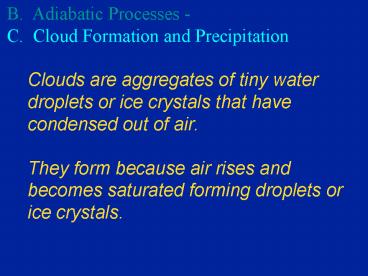B' Adiabatic Processes - PowerPoint PPT Presentation
1 / 25
Title:
B' Adiabatic Processes
Description:
Hail - bigger than golf balls is rare. Rime (ice feathers) B. Adiabatic Processes ... air masses collide (nowhere to go but up) B. Adiabatic Processes ... – PowerPoint PPT presentation
Number of Views:48
Avg rating:3.0/5.0
Title: B' Adiabatic Processes
1
B. Adiabatic Processes - C. Cloud Formation and
Precipitation Clouds are aggregates of tiny
water droplets or ice crystals that have
condensed out of air. They form because air
rises and becomes saturated forming droplets
or ice crystals.
2
Precipitation
What causes water droplets in clouds to join
together (coalesce) into drops big enough to
fall to the ground without evaporating ??? A
raindrop big enough contains a million times
more water than a cloud droplet!!!
3
In the collision- coalescence process,
large droplets start to fall and sweep up
smaller ones.
4
In the Bergeron Process, ice crystals grow at
the expense of cloud droplets
5
Types of Precipitation
Rain and Drizzle Snow - cold air is dry and
tends to produce powder (lets hit the
slopes) Sleet and Glaze Hail - bigger than golf
balls is rare Rime (ice feathers)
6
B. Adiabatic Processes - C. Cloud Formation and
Precipitation cold air up high - cold
low - get snow - warm low - melts on way
down and forms rain
7
B. Adiabatic Processes - C. Cloud Formation and
Precipitation warm air up high - warm
air low - get rain - cold air low - rain
freezes down low to form sleet
8
B. Adiabatic Processes - C. Cloud Formation and
Precipitation air rises because warm air
rises -
9
B. Adiabatic Processes - C. Cloud Formation and
Precipitation air rises because warm air
rises - orographic lifting - rain
shadow air pushed over mountains cools
as rises and rains warms on way down other
side - dry air
10
Rain
Rain shadow desert
Lifting
11
B. Adiabatic Processes - C. Cloud Formation and
Precipitation air rises because warm air
rises - orographic lifting - rain shadow
frontal wedging - warm air rises over cold
air
12
warm
cold
warm
cold
13
B. Adiabatic Processes - C. Cloud Formation and
Precipitation air rises because warm air
rises - orographic lifting - rain shadow
frontal wedging - convergent lifting -
air masses collide (nowhere to go but up)
14
B. Adiabatic Processes - C. Cloud Formation and
Precipitation 1. air rises and becomes
saturated forming drops or ice crystals
- 2. air rises because 3. Types of clouds
15
B. Adiabatic Processes - C. Cloud Formation and
Precipitation 1. air rises and becomes
saturated forming drops or ice crystals
- 2. air rises because 3. Types of
clouds a. Cirrus - high, white, thin
patchy, wispy (ice crystals)
16
Cirrus
17
Cirrus
18
B. Adiabatic Processes - C. Cloud Formation 1.
air rises and becomes saturated
forming drops or ice crystals - 2. air
rises because 3. Types of clouds a. Cirrus
- high, white, thin b. Cumulus - individual
puffs usually flat on bottom
19
Cirro - High Alto - Middle
Cirrocumulus
Altocumulus
Cumulus
Stratocumulus
20
Cumulus
21
Cumulus
22
AltoCumulus
23
B. Adiabatic Processes - C. Cloud Formation and
Precipitation 1. air rises and becomes
saturated forming drops or ice crystals
- 2. air rises because 3. Types of
clouds a. Cirrus - high, white, thin b.
Cumulus - individual puffs c. Stratus -
sheets or layers cover entire sky
24
Nimbo - rain
Stratus
25
B. Adiabatic Processes - C. Cloud Formation and
Precipitation 1. air rises and becomes
saturated forming drops or ice crystals
- 2. air rises because 3. Types of
clouds a. Cirrus - high, white, thin b.
Cumulus - individual puffs c. Stratus -
sheets or layers cover entire
sky d. Fog - cloud with base at or near
the ground
Atmos 3































